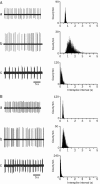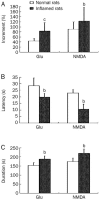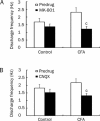Enhanced NMDA receptor NR1 phosphorylation and neuronal activity in the arcuate nucleus of hypothalamus following peripheral inflammation
- PMID: 21293467
- PMCID: PMC4009944
- DOI: 10.1038/aps.2010.190
Enhanced NMDA receptor NR1 phosphorylation and neuronal activity in the arcuate nucleus of hypothalamus following peripheral inflammation
Abstract
AbstractAim:To investigate the role of glutamate and N-methyl-D-aspartate (NMDA) receptors in central sensitization following peripheral inflammation in the arcuate nucleus (ARC) of the mediobasal hypothalamus.
Methods: Mediobasal hypothalamic slices were prepared from rats undergoing peripheral inflammation, which was induced by a unilateral injection of complete Freund's adjuvant (CFA) into hind paw. Neuronal activation levels in the ARC were monitored by recording extracellular unit discharges. The NMDA receptor NR1 subunit (NR1) was measured using Western blot analysis.
Results: Enhanced NR1 phosphorylation was observed in the ARC of CFA-inflamed rats. Compared with the control rats, the firing rate of spontaneous discharges in ARC neurons of inflamed rats was significantly higher, and it was significantly reduced both by an NMDA receptor antagonist (MK-801, 300 μmol/L) and by a non-NMDA receptor antagonist (CNQX, 30 μmol/L). Application of exogenous glutamate (200 μmol/L) or NMDA (25 μmol/L) resulted in increased neuronal discharges for ARC neurons, which was enhanced to a greater extent in inflamed rats than in control rats.
Conclusion: Glutamate receptor activation in the hypothalamic ARC plays a crucial role in central sensitization associated with peripheral inflammation.
Figures





Similar articles
-
Phosphorylation of NR2B NMDA subunits by protein kinase C in arcuate nucleus contributes to inflammatory pain in rats.Sci Rep. 2015 Oct 30;5:15945. doi: 10.1038/srep15945. Sci Rep. 2015. PMID: 26515544 Free PMC article.
-
Arcuate Src activation-induced phosphorylation of NR2B NMDA subunit contributes to inflammatory pain in rats.J Neurophysiol. 2012 Dec;108(11):3024-33. doi: 10.1152/jn.01047.2011. Epub 2012 Sep 19. J Neurophysiol. 2012. PMID: 22993256
-
The role of peripheral N-methyl-D-aspartate receptors in Freund's complete adjuvant induced mechanical hyperalgesia in rats.Neurosci Lett. 2001 Jan 19;297(3):155-8. doi: 10.1016/s0304-3940(00)01662-1. Neurosci Lett. 2001. PMID: 11137751
-
N-methyl-D-aspartate-induced excitation and sensitization of normal and inflamed nociceptors.Neuroscience. 2003;118(2):547-62. doi: 10.1016/s0306-4522(03)00009-5. Neuroscience. 2003. PMID: 12699789
-
Characterization of ionotropic glutamate receptor-mediated nitric oxide production in vivo in rats.Stroke. 1997 Apr;28(4):850-6; discussion 856-7. doi: 10.1161/01.str.28.4.850. Stroke. 1997. PMID: 9099207
Cited by
-
Regulation of the firing activity by PKA-PKC-Src family kinases in cultured neurons of hypothalamic arcuate nucleus.J Neurosci Res. 2020 Feb;98(2):384-403. doi: 10.1002/jnr.24516. Epub 2019 Aug 12. J Neurosci Res. 2020. PMID: 31407399 Free PMC article.
-
Neurexin-2 is a potential regulator of inflammatory pain in the spinal dorsal horn of rats.J Cell Mol Med. 2020 Dec;24(23):13623-13633. doi: 10.1111/jcmm.15707. Epub 2020 Nov 8. J Cell Mol Med. 2020. PMID: 33164324 Free PMC article.
-
Pluripotential GluN1 (NMDA NR1): Functional Significance in Cellular Nuclei in Pain/Nociception.Int J Mol Sci. 2023 Aug 25;24(17):13196. doi: 10.3390/ijms241713196. Int J Mol Sci. 2023. PMID: 37686003 Free PMC article. Review.
-
Src activation in the hypothalamic arcuate nucleus may play an important role in pain hypersensitivity.Sci Rep. 2019 Mar 7;9(1):3827. doi: 10.1038/s41598-019-40572-z. Sci Rep. 2019. PMID: 30846840 Free PMC article.
-
Phosphorylation of NR2B NMDA subunits by protein kinase C in arcuate nucleus contributes to inflammatory pain in rats.Sci Rep. 2015 Oct 30;5:15945. doi: 10.1038/srep15945. Sci Rep. 2015. PMID: 26515544 Free PMC article.
References
-
- Dingledine K, Borges K, Bowie D, Traynelis S. The glutamate receptor ion channels. Pharmacol Rev. 1999;51:7–61. - PubMed
-
- Fundytus ME. Glutamate receptors and nociception: implications for the drug treatment of pain. CNS Drugs. 2001;15:29–58. - PubMed
-
- Petrenko AB, Yamakura T, Baba H, Shimoji K. The role of N-methyl-D-aspartate (NMDA) receptors in pain: a review. Anesth Analg. 2003;97:1108–16. - PubMed
-
- Rygh LJ, Svendsen F, Hole K, Tjolsen A. Natural noxious stimulation can induce long-term increase of spinal nociceptive responses. Pain. 1999;82:305–10. - PubMed
-
- Sandkuhler J, Liu X. Induction of long-term potentiation at spinal synapse by noxious stimulation or nerve injury. Eur J Neurosci. 1998;10:2476–80. - PubMed
Publication types
MeSH terms
Substances
LinkOut - more resources
Full Text Sources

